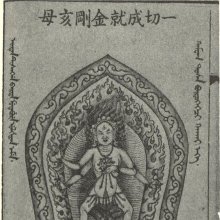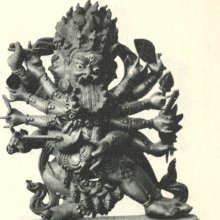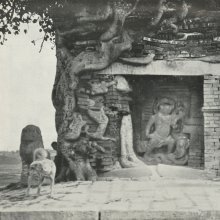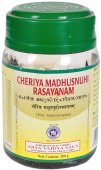Varahi, Varāhī, Vārāhī, Vārāhi: 29 definitions
Introduction:
Varahi means something in Buddhism, Pali, Hinduism, Sanskrit, Jainism, Prakrit, Marathi, biology. If you want to know the exact meaning, history, etymology or English translation of this term then check out the descriptions on this page. Add your comment or reference to a book if you want to contribute to this summary article.
Images (photo gallery)
(+1 more images available)
In Hinduism
Ayurveda (science of life)
Rasashastra (Alchemy and Herbo-Mineral preparations)
Source: Wisdom Library: Rasa-śāstra1) Vārāhī (वाराही):—One of the sixty-four Divyauṣadhi, which are powerful drugs for solidifying mercury (rasa), according to Rasaprakāśa-sudhākara (chapter 9).
2) Vārāhī (वाराही):—One of the sixty-eight Rasauṣadhi, very powerful drugs known to be useful in alchemical processes related to mercury (rasa), according to Rasaprakāśa-sudhākara (chapter 9).
Kalpa (Formulas, Drug prescriptions and other Medicinal preparations)
Source: Ancient Science of Life: Evaluation of Cyavanaprāśa on Health and Immunity related Parameters in Healthy ChildrenVārāhī (वाराही) refers to the medicinal plant known as Dioscorea bulbifera, Rt. Tr., and is used in the Ayurvedic formulation known as Cyavanaprāśa: an Ayurvedic health product that helps in boosting immunity.—Cyavanaprāśa has been found to be effective as an immunity booster, vitalizer and a preventer of day to day infections and allergies such as common cold and cough etc. It is a classical Ayurvedic formulation comprising ingredients such as Vārāhī. [...] Cyavanaprāśa can be consumed in all seasons as it contains weather friendly ingredients which nullify unpleasant effects due to extreme environmental and climatic conditions.
Source: Shodhganga: Edition translation and critical study of yogasarasamgrahaVārāhī (वाराही) refers to the medicinal plant known as “Dioscorea bulbifera Linn.” and is dealt with in the 15th-century Yogasārasaṅgraha (Yogasara-saṅgraha) by Vāsudeva: an unpublished Keralite work representing an Ayurvedic compendium of medicinal recipes. The Yogasārasaṃgraha [mentioning vārāhī] deals with entire recipes in the route of administration, and thus deals with the knowledge of pharmacy (bhaiṣajya-kalpanā) which is a branch of pharmacology (dravyaguṇa).
Agriculture (Krishi) and Vrikshayurveda (study of Plant life)
Source: Shodhganga: Drumavichitrikarnam—Plant mutagenesis in ancient IndiaVarāhī (वराही) (identified with Dioscorea bulbifera) is used in a recipe for producing flowers and fruits out-of-season (akāla), according to the Vṛkṣāyurveda by Sūrapāla (1000 CE): an encyclopedic work dealing with the study of trees and the principles of ancient Indian agriculture.—Accordingly: “Trees produce flowers and fruits out of season undoubtedly if the following procedure is followed: Dioscorea bulbifera [e.g., Varāhī], Cuminum cyminum seed and sugarcane juice should be kept for a month in a pot containing clarified butter prepared in the moonlight and when the mixture is well formed, roots of the trees should be smeared with it and the basin should be filled with mud. Then sugarcane juice should be profusely sprinkled and the trees should be smoked with honey and kuṇapa”.

Āyurveda (आयुर्वेद, ayurveda) is a branch of Indian science dealing with medicine, herbalism, taxology, anatomy, surgery, alchemy and related topics. Traditional practice of Āyurveda in ancient India dates back to at least the first millenium BC. Literature is commonly written in Sanskrit using various poetic metres.
Shaktism (Shakta philosophy)
Source: Wisdom Library: Śāktism1) Vārāhī (वाराही) refers to the sixth of the eight Aṣṭamātṛkā (mother Goddesses) of Kathmandu city, locally known as Phibva Ajimā. Her location is Maitīghar.
2) Vārāhī (वाराही):—Name of one of the mātṛs to be worshipped during Āvaraṇapūjā (“Worship of the Circuit of Goddesses”, or “Durgā’s Retinue”), according to the Durgāpūjātattva. They should be worshipped with either the five upācāras or perfume and flowers.
Her mantra is as follows:
Source: Google Books: Manthanabhairavatantramॐ वाराह्यै नमः
oṃ vārāhyai namaḥ.
1) Vārāhī (वाराही) is the name of a Mātṛkā (‘mother’) and is identified with the sacred site of Jayantikā, according to the Manthānabhairavatantra, a vast sprawling work that belongs to a corpus of Tantric texts concerned with the worship of the goddess Kubjikā.—According to the Kubjikā Tantras, the eight major Kaula sacred sites each have a house occupied by a woman of low caste who is identified with a Mother (Mātṛkā).—[...] Jayantikā is identified with (a) the class of ball-making woman (kaṇḍukī) [or leather worker (carmakāriṇī)], (b) the Mātṛkā or ‘mother’ named Vārāhī, and (c) with the location of ‘drop’.
2) Vārāhī (वाराही) refers to one of the eight Kaula consort (dūtī-aṣṭaka) associated with Avyaktapīṭha (i.e., ‘the unmanifest seat’ representing the act of churning—manthāna), according to the Manthānabhairavatantra.—[...] The eight Kaula consort (dūtyaṣṭaka): Brahmāṇī, Vaiṣṇavī, Raudrī, Mātaṅgī, Carcikeśvarī, Vārāhī, Nārasiṃhī, Śivādūtī.
Source: Sreenivasarao's blog: Saptamatrka (part 4)Varahi refers to one of the seven mother-like goddesses (Matrika).—The Matrikas emerge as shaktis from out of the bodies of the gods: Varahi from Varaha. The order of the Saptamatrka usually begins with Brahmi symbolizing creation. Then, Vaishnavi, Maheshvari and Kaumari. Then, Varahi is the power and aggressive intent to go after enjoyment.
The Bhavanopanishad (9) recognizes Matrikas as eight types of un-favourable dispositions, such as: desire, anger, greed, delusion, pride, jealousy, demerit and merit. Tantra-raja-tantra (36; 15-16) expands on that and identifies Varahi with pride and arrogance (mada).
According to Khadgamala (vamachara) tradition of Sri Vidya, the eight Matrkas are located along the wall (four at the doors and four at the corners) guarding the city (Tripura) on all eight directions: Varahi on North-west.
Source: Kamakoti Mandali: The Yoginis of Narasimha VyuhaVārāhī (वाराही) is the name of a Mātṛkā-Śakti created by Mahārudra in order to control the plague of demons created by Andhakāsura.—Accordingly, Andhaka-Asura tried to kidnap Umā (Devī Pārvatī), and was fiercely attacked by Mahārudra who shot arrows at him from his mahāpināka. when the arrows pierced the body of Andhakāsura, drops of blood fell to earth and from those drops, thousands of Andhakas arose. To control this plague of demons, Mahārudra created Mātṛkā-Śaktis [viz., Vārāhī] and ordered them to drink the blood of the demons and drain them dry.
Source: Kamakoti Mandali: Nrisimha matrika-mandalaVārāhī (वाराही) refers to one of the various Mātṛkā-Śaktis created by Rudra in order to destroy the clones that spawned from Andhaka’s body.—Accordingly, [...] Andhakāsura attempted to abduct Girājanandinī (Pārvatī) and thus ensued a fierce battle between Andhakāsura and the great Rudra, the Lord of Umā. Like raktabīja, every drop of blood that fell from the body of Andhaka created another Asura like him and in no time, the entire world was filled with Andhakas. To destroy the growing number of Andhakas, Rudra created innumerable Mātṛkā-Śaktis [viz., Vārāhī]. These Śaktis of immense power at once began to drink every drop of blood that flowed from the body of Andhaka, but they could still not effectively contain the emergence of more and more demons.

Shakta (शाक्त, śākta) or Shaktism (śāktism) represents a tradition of Hinduism where the Goddess (Devi) is revered and worshipped. Shakta literature includes a range of scriptures, including various Agamas and Tantras, although its roots may be traced back to the Vedas.
Purana and Itihasa (epic history)
Source: Wisdom Library: The Matsya-purāṇaVārāhī (वाराही) is the name of a mind-born ‘divine mother’ (mātṛ), created for the purpose of drinking the blood of the Andhaka demons, according to the Matsya-purāṇa 179.8. The Andhaka demons spawned out of every drop of blood spilled from the original Andhakāsura (Andhaka-demon). According to the Matsya-purāṇa 179.35, “Most terrible they (e.g., Vārāhī) all drank the blood of those Andhakas and become exceedingly satiated.”
The Matsyapurāṇa is categorised as a Mahāpurāṇa, and was originally composed of 20,000 metrical verses, dating from the 1st-millennium BCE. The narrator is Matsya, one of the ten major avatars of Viṣṇu.
Source: Cologne Digital Sanskrit Dictionaries: The Purana Index1) Vārāhi (वाराहि).—A Pravara (Angiras).*
- * Matsya-purāṇa 196. 12, 13.
2a) Vārāhī (वाराही).—A surname of Lalitā.*
- * Brahmāṇḍa-purāṇa IV. 17. 19.
2b) A Śakti; a mind-born mother.1 Icon of, with buffalo mount.2
2c) A R. of the Varāhadvīpam.*
- * Vāyu-purāṇa 48. 39.

The Purana (पुराण, purāṇas) refers to Sanskrit literature preserving ancient India’s vast cultural history, including historical legends, religious ceremonies, various arts and sciences. The eighteen mahapuranas total over 400,000 shlokas (metrical couplets) and date to at least several centuries BCE.
Shilpashastra (iconography)
Source: Sreenivasarao's blog: Saptamatrka (part 4) (shilpa)Varahi refers to the fifth Matrka and is the shakthi of Varaha.—Varahi is shown with the face of a boar and having dark complexion resembling the storm cloud. She is sometimes called Dhruma Varahi (dark Varahi) and Dhumavati (goddess of darkness). Varahi is seated under Kalpaka tree. And, her vahana as well as the emblem on her banner is an elephant. She wears on her head a karanda-makuta and is adorned with ornaments made of corals. She wears on her legs Nupura-anklets. She wields the hala and the shakti and is seated under a Kalpaka tree. The Purva-Karanayama says that she carries Sarnga-Dhanush (bow), the hala (plough) and musula (pestle) as her weapons.
In the Raktabija episode of Devi-purana, Varahi is described as having a boar form, fighting demons with her tusks while seated on a Preta (ghoul). To this description the Vishnudharmottara adds that Varahi has a big belly and six hands, in four of which she carries the danda (staff of punishment), khetaka (shield), khadga (sword), and pasha (noose); while the two other hands gesture Abhaya and Varada mudras.

Shilpashastra (शिल्पशास्त्र, śilpaśāstra) represents the ancient Indian science (shastra) of creative arts (shilpa) such as sculpture, iconography and painting. Closely related to Vastushastra (architecture), they often share the same literature.
In Buddhism
Tibetan Buddhism (Vajrayana or tantric Buddhism)
Source: Wisdom Library: Tibetan Buddhism1) Vārāhī (वाराही) is the name of one of the six family deities presiding over twenty-four sacred districts, according to the Vajraḍākavivṛti commentary on the 9th-centruy Vajraḍākatantra.—These six Yoginīs seems most likely to represent female leaders of six families [viz., Vārāhī]. The Vajraḍākavivṛti clearly connects twenty-four districts with the system of six families. Accordingly, the Vārāhī family comprises the districts Kulatā, Maru, Pretapurī (Pretādhivāsinī) and Triśakuni.
2) Vārāhī (वाराही) also refers to one of the various Mātṛs and Mahāmātṛs mentioned as attending the teachings in the 6th century Mañjuśrīmūlakalpa.
Source: archive.org: The Indian Buddhist IconographyVārāhī (वाराही) is the name of a Goddess commonly depicted in Buddhist Iconography, and mentioned in the 11th-century Niṣpannayogāvalī of Mahāpaṇḍita Abhayākara.—Her Colour is blue; her Symbol is he fish; her Vehicle is the owl; she has four arms.
Vārāhī is described in the Niṣpannayogāvalī (dharmadhātuvāgīśvara-maṇḍala) as follows:—
Source: academia.edu: A Critical Sanskrit Edition and a Translation of Kambala’s Sādhananidhi, Chapter 8“Vārāhī is blue in colour. She rides on an Owl and is four-armed. In one pair of hands she shows the Rohita fish in the right and the kapāla in the left. Two others are clasped in añjali”.
1) Vārāhī (वाराही) is the name of a deity associated with the syllable “śrī” of the Heart Mantra of Heruka (hṛdayamantra): one of the four major mantras in the Cakrasaṃvara tradition, as taught in the eighth chapter of the 9th-century Herukābhidhāna and its commentary, the Sādhananidhi. The Hṛdaya-mantra consists of twenty-two letters. [...] A practitioner in meditation visualizes that twenty-two deities [viz., Vārāhī] are developed from the twenty-two letters constituting the mantra. Each letter of the mantra is used as the initial letter of each deity’s name except for the first and second deities, who are the chief couple deities and located at the center of the maṇḍala.
2) Vārāhī (वाराही) is also the name of a Yoginī associated with the syllable “vaṃ” of the Ṣaḍyoginīmantra (six yoginī mantra): another one of the four major mantras in the Cakrasaṃvara tradition. The Ṣaḍyoginī-mantra consists of six mantras taught to be the six Yoginīs. [...] These six Yoginīs are also found in Nāgārjuna’s Dharmasaṃgraha. A practitioner visualizes them [viz., Vārāhī] without male companions. Alternatively, a practitioner visualizes them with their male consorts such as Vajrasattva.
3) Vārāhī (वाराही) (alias Vajravārāhī) is also the name of a Deity associated with the syllable “hā” of the Devīhṛdayamantra (Goddess’ heart mantra): another one of the four major mantras in the Cakrasaṃvara tradition. The thirteen letters constituting the mantra are transformed in meditation into thirteen deities. All these female deities [viz., Vārāhī] have their male consorts who resemble their consort female deities in appearance and are in sexual union with them.
Source: academia.edu: The Structure and Meanings of the Heruka MaṇḍalaVārāhī (वाराही) refers to the Ḍākinī of the south-eastern corner in the Medinīcakra, according to the 10th century Ḍākārṇava chapter 15. Accordingly, the medinīcakra refers to one of the three divisions of the dharma-puṭa (‘dharma layer’), situated in the Herukamaṇḍala. Two colors are evenly assigned to the four corner Ḍākinīs [viz., Vārāhī] in order in accordance with the direction which they face.
Source: OSU Press: Cakrasamvara SamadhiVārāhī (वाराही) [=vārāhīka?] refers to a “beloved sow” [?], according to the Ṭīkā Pot Worship [i.e., Kalaśapūjā] ritual often performed in combination with the Cakrasaṃvara Samādhi, which refers to the primary pūjā and sādhanā practice of Newah Mahāyāna-Vajrayāna Buddhists in Nepal.—Accordingly, “Rising out across the circle, that kindles the wind, of a hundred shining suns, A burning triad, infatuating the three worlds, an overflowing stream of nectar, Giving her own abundant bliss, having the pure essence of Buddha knowledge, Free from traversing existence and non-existence, beloved sow (vārāhīka), drink to you”.

Tibetan Buddhism includes schools such as Nyingma, Kadampa, Kagyu and Gelug. Their primary canon of literature is divided in two broad categories: The Kangyur, which consists of Buddha’s words, and the Tengyur, which includes commentaries from various sources. Esotericism and tantra techniques (vajrayāna) are collected indepently.
General definition (in Buddhism)
Source: Wisdom Library: Dharma-samgrahaVārāhī (वाराही) refers to the second of the “six Yoginīs” (ṣaḍyoginī) as defined in the Dharma-saṃgraha (section 13). The Dharma-samgraha (Dharmasangraha) is an extensive glossary of Buddhist technical terms in Sanskrit (e.g., ṣaṣ-yoginī and Vārāhī). The work is attributed to Nagarguna who lived around the 2nd century A.D.
In Jainism
General definition (in Jainism)
Source: archive.org: The Jaina IconographyVārāhī (वाराही) is the name of a Yoginī mentioned in various Jaina manuscripts, often being part of a list of sixty-four such deities. How the cult of the Tantrik Yoginīs originated among the vegetarian Jainas is unknown. The Yoginīs (viz., Vārāhī) are known as attendants on Śiva or Pārvatī. But in the case of Jainism, we may suppose, as seen before that they are subordinates to Kṣetrapāla, the chief of the Bhairavas.
Source: archive.org: TrisastisalakapurusacaritraVārāhī (वाराही) is the name of a vidyā subdued by Rāvaṇa, according to the Jain Ramayana and chapter 7.1 [origin of the rākṣasavaṃśa and vānaravaṃśa] of Hemacandra’s 11th century Triṣaṣṭiśalākāpuruṣacaritra: an ancient Sanskrit epic poem narrating the history and legends of sixty-three illustrious persons in Jainism.
Accordingly, “[...] Rāvaṇa, knowing the highest good, not considering it worthless, remained motionless like a high mountain, absorbed in preeminent meditation. ‘Well done! Well done!’ was the cry of gods in the sky, and the Yakṣa-servants departed quickly, terrified. One thousand vidyās, the sky being lighted up by them, came to Daśāsya (=Rāvaṇa), saying aloud, ‘We are subject to you.’ [e.g., Vārāhī, ...] great vidyās beginning with these were subdued by noble Daśāsya in just a few days because of his former good acts. [...]”.

Jainism is an Indian religion of Dharma whose doctrine revolves around harmlessness (ahimsa) towards every living being. The two major branches (Digambara and Svetambara) of Jainism stimulate self-control (or, shramana, ‘self-reliance’) and spiritual development through a path of peace for the soul to progess to the ultimate goal.
Biology (plants and animals)
Source: Wisdom Library: Local Names of Plants and DrugsVarahi [वराही] in the Sanskrit language is the name of a plant identified with Ipomoea batatas (L.) Lam. from the Convolvulaceae (Morning glory) family having the following synonyms: Convolvulus batatas, Batatas edulis, Ipomoea edulis. For the possible medicinal usage of varahi, you can check this page for potential sources and references, although be aware that any some or none of the side-effects may not be mentioned here, wether they be harmful or beneficial to health.

This sections includes definitions from the five kingdoms of living things: Animals, Plants, Fungi, Protists and Monera. It will include both the official binomial nomenclature (scientific names usually in Latin) as well as regional spellings and variants.
Languages of India and abroad
Pali-English dictionary
Source: BuddhaSasana: Concise Pali-English Dictionaryvarāhī : (f.) a sow.

Pali is the language of the Tipiṭaka, which is the sacred canon of Theravāda Buddhism and contains much of the Buddha’s speech. Closeley related to Sanskrit, both languages are used interchangeably between religions.
Marathi-English dictionary
Source: DDSA: The Molesworth Marathi and English Dictionaryvārāhī (वाराही).—f A plant, the Yam, Dioscorea. vārāhī- kanda m The root of it, a yam.
Marathi is an Indo-European language having over 70 million native speakers people in (predominantly) Maharashtra India. Marathi, like many other Indo-Aryan languages, evolved from early forms of Prakrit, which itself is a subset of Sanskrit, one of the most ancient languages of the world.
Sanskrit dictionary
Source: DDSA: The practical Sanskrit-English dictionaryVārāhī (वाराही).—
1) A sow.
2) The earth.
3) The Śakti of Viṣṇu in the form of a boar.
4) A measure.
Source: Cologne Digital Sanskrit Dictionaries: Monier-Williams Sanskrit-English Dictionary1) Varāhī (वराही):—[from varāha] f. a species of Cyperus, [cf. Lexicographers, esp. such as amarasiṃha, halāyudha, hemacandra, etc.]
2) [v.s. ...] Batatas Edulis, [cf. Lexicographers, esp. such as amarasiṃha, halāyudha, hemacandra, etc.]
3) Vārāhī (वाराही):—[from vārāha] a f. See below
4) [from vārāha] b f. a sow, [Horace H. Wilson]
5) [v.s. ...] the Śakti or female Energy of the Boar form of Viṣṇu, [Yājñavalkya [Scholiast or Commentator]]
6) [v.s. ...] Name of one of the Mātṛs attending on Skanda, [Mahābhārata]
7) [v.s. ...] a kind of bulbous plant, Dioscorea, [Varāha-mihira’s Bṛhat-saṃhitā]
8) [v.s. ...] the earth, [Horace H. Wilson]
9) [v.s. ...] a measure, [ib.]
10) [v.s. ...] Name of a river, [Catalogue(s)]
Source: Cologne Digital Sanskrit Dictionaries: Yates Sanskrit-English DictionaryVārāhī (वाराही):—(hī) 1. f. An esculent root, yam; one of the divine mothers; a measure; the earth; a sow.
Source: DDSA: Paia-sadda-mahannavo; a comprehensive Prakrit Hindi dictionary (S)Varāhī (वराही) in the Sanskrit language is related to the Prakrit words: Varāhī, Vārāhī.
Sanskrit, also spelled संस्कृतम् (saṃskṛtam), is an ancient language of India commonly seen as the grandmother of the Indo-European language family (even English!). Closely allied with Prakrit and Pali, Sanskrit is more exhaustive in both grammar and terms and has the most extensive collection of literature in the world, greatly surpassing its sister-languages Greek and Latin.
Prakrit-English dictionary
Source: DDSA: Paia-sadda-mahannavo; a comprehensive Prakrit Hindi dictionary1) Varāhī (वराही) in the Prakrit language is related to the Sanskrit word: Varāhī.
2) Vārāhī (वाराही) also relates to the Sanskrit word: Vārāhī.
Prakrit is an ancient language closely associated with both Pali and Sanskrit. Jain literature is often composed in this language or sub-dialects, such as the Agamas and their commentaries which are written in Ardhamagadhi and Maharashtri Prakrit. The earliest extant texts can be dated to as early as the 4th century BCE although core portions might be older.
Kannada-English dictionary
Source: Alar: Kannada-English corpusVārāhi (ವಾರಾಹಿ):—
1) [noun] a female pig.
2) [noun] name of one of the seven mother goddesses.
3) [noun] the plant Dioscorea globosa of Dioscoreaceae family.
4) [noun] its starch, tuberous rout.
5) [noun] name of one of the rivers in the Karnataka, that has its origin in Śivamoga district, and empties in Arabian sea.
6) [noun] (mus.) the presiding goddess of pancama, the fifth note in the Indian scale (corresponding to G of Western music).
Kannada is a Dravidian language (as opposed to the Indo-European language family) mainly spoken in the southwestern region of India.
See also (Relevant definitions)
Starts with: Varahika, Varahikanda, Varahikavaca, Varahimalamantra, Varahina, Varahinigrahashtaka, Varahiprashna, Varahipuja, Varahiputra, Varahisahasranamastotra, Varahistotra, Varahitantra, Varahitantre saptashatividhanam, Varahiya.
Ends with: Aryavajravarahi, Niravarahi, Shrivajravarahi, Vajravarahi, Vashikaravarahi, Vasyavajravarahi.
Full-text (+94): Varahitantra, Varahikanda, Ashtamatrika, Vajravarahi, Matri, Saptamatri, Shadyogini, Varahistotra, Varahiputra, Varahiprashna, Varahinigrahashtaka, Varahisahasranamastotra, Varahakanta, Villamula, Saptamatrika, Svapnavarahikalpa, Dakshinamnaya, Varahyanugrahashtaka, Vashikaravarahi, Varahanamin.
Relevant text
Search found 40 books and stories containing Varahi, Varāhī, Vārāhī, Vārāhi, Vaarahi; (plurals include: Varahis, Varāhīs, Vārāhīs, Vārāhis, Vaarahis). You can also click to the full overview containing English textual excerpts. Below are direct links for the most relevant articles:
Lalitopakhyana (Lalita Mahatmya) (by G.V. Tagare)
The chariot of Daṇḍanāthā (Kiricakra)
Chapter 20 - The Deities on the Kiricakraratha
Temples of Munnur (Historical Study) (by R. Muthuraman)
Varahi Tantra (English Study) (by Roberta Pamio)
Historical Elements in the Matsya Purana (by Chaitali Kadia)
Lineages of Aṅgirā < [Chapter 6 - Human history in the Matsya-Purāṇa]
Iconography in the Matsya Purāṇa < [Chapter 5 - Cultural history in the Matsya-Purāṇa]
Cidgaganacandrika (study) (by S. Mahalakshmi)
Verse 70 [Pralayāgni] < [Chapter 2 - Second Vimarśa]
Puranic encyclopaedia (by Vettam Mani)
Related products










